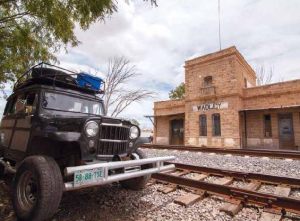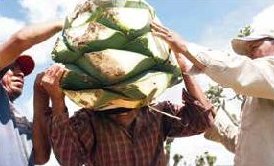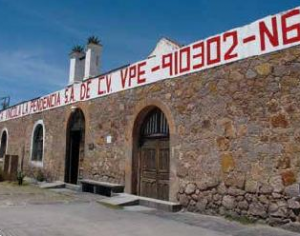In the high plains of central Mexico, the Mezcal Routes are the backbone of cultural traditions, history and identity.
 The mezcal is probably one of the best kept secrets of Mexico. And the rocky network of ancient roads better known as the Mezcal Routes lead us to see the heart of Mexico, to discover that intriguing drink.
The mezcal is probably one of the best kept secrets of Mexico. And the rocky network of ancient roads better known as the Mezcal Routes lead us to see the heart of Mexico, to discover that intriguing drink.
The Potosí Altiplano is the gateway to the Chihuahua de- sert, a semi-desert region locked to two thousand meters high with a great variety of flora and fauna, among which are many species of cacti, small rodents and birds”.
The mezcal factories of the Potosí high plains have a his- tory of over two hundred years, and some have been pro- ducing since them this distillate, reputed to be noble and austere. Visit the factories with their imposing masonry ovens and smell the sweetness of freshly cooked maguey hearts. It will mark forever the way you drink one of those little cuernitos (little horn) full of mezcal: two centuries of experiences contained in an elixir lighter than water but stronger than thunder.
Camino Real
 El Camino Real, the historic road that follows the steps of the first Spanish explorers to the north of Mexico, will lead us to a region of ancient mines and shrines erected to evan- gelize the local population. This is also the route where Fa- ther Miguel Hidalgo ran his army on his way to Saltillo, in the days of his fight for independence.
El Camino Real, the historic road that follows the steps of the first Spanish explorers to the north of Mexico, will lead us to a region of ancient mines and shrines erected to evan- gelize the local population. This is also the route where Fa- ther Miguel Hidalgo ran his army on his way to Saltillo, in the days of his fight for independence.
Here, in Venado, we visit the Cultural Center “Roberto Do- nis”, located in a former textile factory that in the late XIX century used water power to generate energy. This center hosts an important collection of Australian aboriginal pie- ces, folk art and works by Donis. Next, we stop by the Charcas mining site, where we will have opportunity to taste the famous railroad gorditas and take a closer look to some of the old haciendas.
Very soon we will enter the region of the maguey (woodrat), at the foot of the mountain, where still stand two of the more imposing mezcal factories, Laguna Seca and Santa Isabel, the former from the XVIII century, the latter from the XIX. Both have masonry structures, arbours and large kilns. You can also visit another impressive mezcal factory in Zaragoza de Solis, born in the early years of this century on the initiative of a rural cooperative. Here we can see how new technologies are applied to produce mezcal, and also meet a new business vision for the distillate.
Salt Mines
The route leads to the west of the state, to the municipality of Salinas, home of one of the most unusual industrial faci- lities in the highlands: salt factories. Scattered over a large salt lake of marine origin, these factories have supplied the farms beneficiating silver and gold.
On the way, you can visit the Ipiña and Santa Tereza mezcal factories, both in the municipality of Ahualulco. While San- ta Teresa prospered by farming, Ipiña benefited from the laying of the railway and the construction of a station that served as a delivery port for the mezcal.
Of the last two mezcal factories of this tour, Saldaña and La Pendencia, both in the town of Pinos, Zacatecas, you can’t miss La Pendencia, that has worked continuously for almost two hundred years.
The Altiplano Gastronomy
 The riches of the Potosi Altiplano go beyond mezcal and mineral resources. The desert flora is diverse and changes from season to season.
The riches of the Potosi Altiplano go beyond mezcal and mineral resources. The desert flora is diverse and changes from season to season.
Spring, for instance, is the time to enjoy some typical pro- ducts of Lent, like cabuches (the button from the biznaga flower) and chochas (flowers from izotes or maguey, the woodcock) prepared in stews, pickled honey or brown su- gar. It’s also the season for the Castilla pumpkin apricots.
In the highlands, August is the time when many varieties of cactus are harvested. The most wanted are the white one, very juicy and sweet, and the cardona cactus, red and small. The latter is used to produce a typical regional drink: the colonche. It is also time to gather garambullos, a blackber- ry-like red fruit of a cactus.
Throughout the year, besides mezcal, the Altiplano offersnopales, jacubes and palmettos, which are prepared in vari- ous stews with pork, chicken, rabbit, or pickled and canned. It also offers such exotic dishes as rabbit and vole, either in a broth seasoned with dried chili sauces, or simply grilled. The escamoles and the red worm from the maguey have been incorporated to the kitchen in recent years, and they already have a great acceptance. Just try them.
The traditional cuisine of the high plains, apart from the products from the desert, makes use of a variety of fruits and vegetables from farms producing near the water holes. Among the typical delicatessen, you can’t skip the ovengorditas (which in some communities are call condoches), the cheese gorditas, and a large variety of cheeses from goat’s and cow’s milk. One of the most famous dishes is theasado de boda (wedding roast), marinated beef with a base of dried chiles, herbs and spices.
Finally, there’s no shortage of typical sweets made from milk and nuts, and the jams, jellies and preserves made with fruits from the orchards, including figs, quinces and even nopal and other cactus.
The Best Way to Enjoy the Journey
There are many ways to enjoy some great moments in the Mezcal Routes. But if you are one of those wanting to go straight to the places you’ve heard about and have long wished to visit, there’s nothing better than hiring one of the many tour operators serving the Mezcal Routes. They can even make a special package to suit your own map.
Operators usually leave from San Luis Potosí and take you anywhere in the state. There are guides specialized on the Mezcal Routes, and finally the operators that are based in Mexico and can also take you back-and-forth to San Luis Potosí.